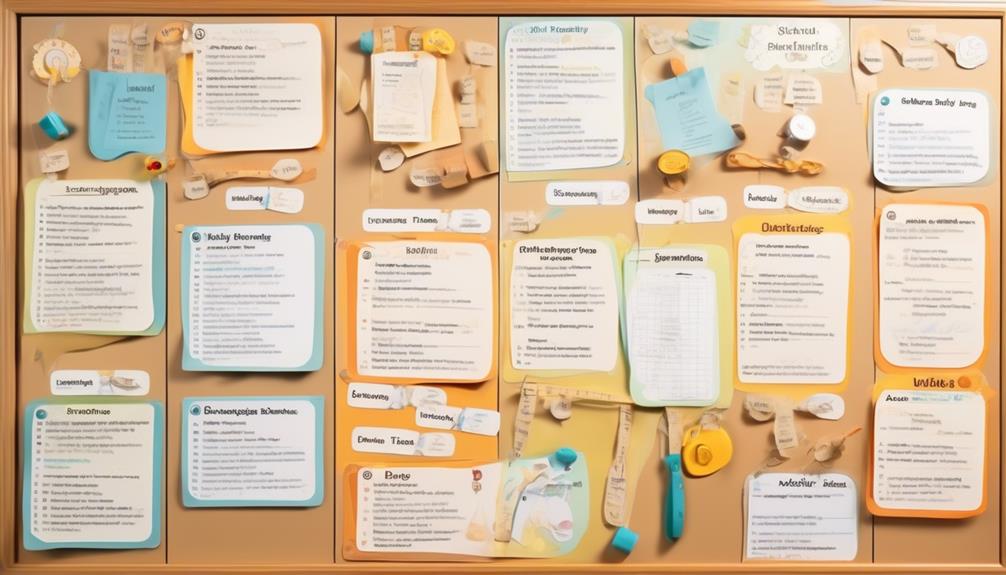Behavior Modification
Effective Strategies for Overcoming Dementia Behavior Challenges at Home
Wander through a labyrinth of 15 powerful strategies to conquer dementia behaviors at home, unlocking a world of transformative solutions.

Navigating the intricate challenges associated with dementia behavior at home might feel as daunting as making your way through dense fog. However, armed with 15 effective strategies, we are able to illuminate the path forward, providing a beacon of hope for both caregivers and those affected.
From identifying triggers to fostering engagement and seeking professional support, these strategies offer a holistic approach to creating a supportive environment.
Join us as we explore the tools and techniques that can make a significant difference in the lives of those affected by dementia.
Key Takeaways
- Minimize noise and distractions, and utilize calming music and soft lighting.
- Create a safe and organized environment to reduce rummaging and hiding habits.
- Develop personalized care plans and utilize music therapy for anger and aggression management.
- Validate experiences, create a calm environment, and use distraction techniques for hallucinations and suspicion.
Identifying Triggers for Behavior Changes
When observing a loved one with dementia, it's crucial to pay close attention to their body language and expressions in order to understand their feelings and emotions. Individuals with dementia may not always be able to communicate their needs verbally, making it essential to be attuned to non-verbal cues. By observing these subtle signs, caregivers can begin to identify triggers for behavior problems that the person may be experiencing.
These triggers could be as simple as hunger, thirst, or discomfort, which, when addressed promptly, can alleviate potential behavioral challenges.
To effectively manage behavior problems in individuals with dementia, it's important to create a supportive environment that caters to their specific needs. Modifying the surroundings to be calming and comforting can help reduce agitation and confusion. Additionally, reflecting on our own reactions to their behaviors is key. Our responses can influence how they react, so remaining patient and understanding is crucial in these situations.
Creating a Calming Environment

When creating a calming environment for someone with dementia, it's crucial to minimize noise and distractions, opt for soft lighting, and place familiar objects strategically.
These adjustments can help reduce anxiety and create a peaceful atmosphere, promoting relaxation and comfort. By implementing these techniques, we aim to provide a soothing space that supports the individual's well-being and overall sense of security.
Noise Reduction Techniques
To create a calming environment at home for individuals with dementia, reducing noise levels is essential to promote relaxation and comfort. Noise reduction techniques play a crucial role in helping to reduce anxiety and confusion in individuals with dementia.
Here are some effective strategies:
- Utilize calming music: Playing soft and soothing music can help create a tranquil atmosphere.
- Minimize background noise: Turn off TVs, radios, and other sources of loud sounds to reduce distractions.
- Provide a gentle touch: Physical touch can be comforting and reassuring for individuals experiencing distress.
Soft Lighting Choices
Soft lighting choices play a crucial role in creating a calming environment for individuals with dementia, promoting relaxation and comfort within the home. When managing dementia-related behavior challenges, it's essential to consider the impact of the environment on their well-being.
Opting for warm, gentle lighting instead of bright fluorescent lights can help maintain a sense of calm and reduce potential agitation. By using lamps or dimmable lights, you can control the ambiance and create a soothing atmosphere that supports better communication and understanding.
Positioning lights strategically to avoid harsh shadows or glare is key to enhancing the overall environment. Experimenting with different lighting options, such as nightlights or motion-activated lights for safety at night, can further contribute to a peaceful and soothing setting for individuals with dementia.
Familiar Object Placement
Creating a calming environment for individuals with dementia involves strategically placing familiar objects to evoke comfort and familiarity, supporting their well-being and reducing stressors. When managing dementia at home, incorporating familiar objects can significantly impact the individual's mood and behavior. Here are some strategies to create a soothing atmosphere for dementia patients:
- Utilize familiar objects as memory aids to assist with daily tasks.
- Place meaningful items like family photos or cherished possessions within easy reach.
- Organize the living space to minimize clutter and confusion, promoting a sense of order and security.
Effective Communication Techniques

When communicating with individuals experiencing dementia, it's crucial to use clear and concise language to ensure understanding.
Active listening skills play a significant role in fostering effective communication and building trust.
Clear and Concise Communication
To effectively communicate with individuals experiencing dementia, simplicity and patience are key elements in facilitating understanding and connection. When engaging with a person with dementia, it's crucial to adapt our communication style to suit their needs.
Here are some strategies for clear and concise communication:
- Use clear and simple language to avoid confusion.
- Utilize visual cues, such as gestures or pictures, to enhance understanding.
- Provide one instruction or question at a time to prevent overwhelming the individual.
Active Listening Skills
As we focus on enhancing our communication with individuals experiencing dementia, actively listening and understanding their expressions become paramount in establishing a meaningful connection. Active listening skills involve fully focusing on what the person with dementia is saying, showing empathy, and using non-verbal cues to demonstrate attentiveness. Here is a table to further illustrate the importance of active listening skills in dealing with dementia:
| Active Listening Skills | Importance | Application |
|---|---|---|
| Focus on the person | Establishes connection | Give undivided attention to their words |
| Reflect emotions | Show empathy | Validate their feelings and experiences |
| Allow them to speak | Respect their pace | Avoid rushing and give time to respond |
Managing Wandering Behaviors

In addressing wandering behaviors in dementia, ensuring a secure environment is crucial for the individual's safety and well-being. Wandering can pose significant risks, so taking proactive measures is essential.
Here are some strategies to effectively manage wandering behaviors:
- Create a safe environment: Securing all doors and using tracking devices can help monitor movements and prevent wandering incidents.
- Establish routines: Daily schedules and engaging in familiar activities provide structure and purpose, reducing restlessness and promoting a sense of security.
- Utilize visual cues: Using signs or labels can help orient the person, reducing confusion and disorientation.
Quality of life for individuals with dementia is greatly impacted by how well their wandering behaviors are managed. Common causes of wandering include disorientation, boredom, or a desire to fulfill unmet needs.
In cases where managing wandering becomes challenging at home, seeking assistance from support groups or considering residential care options that promote physical health and safety may be beneficial. Working together to address wandering behaviors can significantly enhance the individual's well-being and overall quality of life.
Addressing Rummaging and Hiding Habits

After effectively managing wandering behaviors in dementia by creating a secure environment and establishing routines, the next important step is addressing rummaging and hiding habits to further enhance the individual's quality of life. Rummaging and hiding behaviors are common in dementia and can be distressing for both the individual and their family members. To help your loved one cope with these habits, it is crucial to create a safe and organized environment that minimizes opportunities for rummaging and hiding. Using labels and visual cues can assist them in locating their belongings and reduce the urge to hide items. Engaging the person in meaningful activities and providing adequate stimulation can also help distract them from rummaging. Additionally, offering reassurance and support during moments of anxiety or agitation can prevent these behaviors from escalating. Seeking professional help or guidance from dementia care resources is advisable if managing rummaging and hiding habits becomes challenging. Remember, patience and understanding are key in supporting your loved one through these memory-related challenges.
| Strategies for Addressing Rummaging and Hiding Habits |
|---|
| 1. Create a safe and organized environment to reduce opportunities for rummaging and hiding. |
| 2. Use labels and visual cues to help the person locate their belongings and discourage hiding. |
| 3. Engage the person in meaningful activities and provide adequate stimulation to reduce boredom and the need to rummage. |
| 4. Offer reassurance and support when the person becomes anxious or agitated, as this may trigger rummaging or hiding behaviors. |
Coping With Anger and Aggression

Understanding the common occurrence of anger and aggression in individuals with dementia is crucial for effectively coping with these challenging behaviors. It's important to identify triggers and underlying causes of such behaviors to address them effectively.
Here are some strategies that can help reduce aggressive behavior in individuals with dementia:
- Develop a personalized care plan: Tailoring a care plan that suits the individual's needs and preferences can significantly improve their quality of life.
- Utilize music therapy: Music therapy has shown promising results in calming individuals with dementia and can enhance the person's ability to manage their emotions.
- Create a calming environment: Establishing a peaceful and soothing atmosphere can help reduce agitation and promote relaxation in individuals experiencing anger or aggression episodes.
Dealing With Hallucinations and Suspicion

Navigating the complexities of dementia care involves addressing a range of challenging behaviors, from coping with anger and aggression to dealing with hallucinations and suspicion. When it comes to managing hallucinations and suspicion in individuals with Alzheimer's disease, providing emotional support and creating a safe environment are essential for providing comfort and security. Hallucinations and suspicion can cause confusion and distress, leading to a decline in overall well-being. It is crucial to foster a sense of calmness and reassurance in these situations.
To effectively deal with these challenges, here are some strategies that can be implemented:
| Strategies | Description |
|---|---|
| Validate the person's experience | Acknowledge their feelings and experiences without trying to argue or dismiss them. |
| Create a calm and safe environment | Establish a soothing atmosphere to reduce anxiety and fear associated with hallucinations. |
| Use distraction techniques | Engage in different activities to divert their attention and alleviate distress. |
| Consult with a healthcare professional | Seek professional advice to determine if medication or other interventions are necessary. |
| Seek support from dementia care groups | Connect with support groups for insights and strategies on managing hallucinations and suspicion. |
Strategies for Sleep Disturbances

When addressing sleep disturbances in individuals with dementia, there are several key strategies that can be implemented.
Firstly, establishing a consistent bedtime routine is crucial. This routine helps to signal the body that it is time to rest and promotes familiarity, which can be particularly beneficial for individuals with dementia.
Secondly, creating a calm and comfortable sleep environment is important. This can be achieved by reducing noise, light, and distractions in the bedroom. By creating a soothing atmosphere, individuals with dementia may experience better sleep.
Furthermore, encouraging daytime physical activity can aid in promoting tiredness at night. Engaging in physical activity during the day can help to expend energy and contribute to a more restful night's sleep.
Lastly, it is important to consider the impact of caffeine and alcohol intake on sleep patterns. Limiting the consumption of these substances, especially in the late afternoon and evening, can help to regulate sleep and promote better sleep quality.
Tips for Addressing Eating Challenges

To address eating challenges in individuals with dementia, creating a calm and quiet environment during meal times is essential for promoting a positive dining experience. Providing a serene setting can help reduce distractions and anxiety, making it easier for the individual to focus on their meal. Serving familiar and favorite foods can increase interest in eating, improving the overall dining experience. Using visual cues and prompts, such as guiding their hand to their mouth, can assist with the eating process and make it more manageable for the individual. Offering small, frequent meals and snacks throughout the day is crucial to prevent fatigue and ensure adequate nutrition intake, considering the time needed to consume meals with dementia patients.
| Tips for Addressing Eating Challenges | |||
|---|---|---|---|
| Create a calm and distraction-free environment during mealtime | Serve familiar and preferred foods to encourage eating | Offer smaller, more frequent meals and snacks throughout the day | Use adaptive utensils or modified food textures if swallowing difficulties are present |
Providing Personal Care and Attention

In providing personal care and attention to individuals with dementia, we focus on implementing changes in communication during personal care or assistance. It's essential to adapt our approach to cater to the specific needs and challenges faced by someone with dementia. Here are some strategies to enhance the care provided:
- Allowing Time to Process Information: Individuals with dementia may require more time to understand and respond to instructions. Patience and giving them adequate time to process information can help in facilitating a smoother personal care routine.
- Emotional Expression: Encouraging emotional expression can help individuals feel more at ease and engaged during personal care activities. Acknowledging their feelings and providing emotional support can create a more comfortable environment for them.
- Maintaining Quality in Care: Despite the challenges posed by dementia, it's crucial to uphold the quality of care provided. Ensuring that personal care tasks are carried out with diligence and compassion can significantly impact the individual's well-being.
Implementing Structured Routines

As we focus on enhancing personal care and attention for individuals with dementia, implementing structured routines plays a crucial role in providing stability and familiarity in their daily lives. Structured routines can help individuals with dementia understand and better manage their days as dementia progresses. By creating a consistent daily schedule, breaking tasks into manageable steps, and using visual cues like calendars or to-do lists, we can assist the patient and allow for a smoother navigation of daily activities.
To further illustrate the importance of implementing structured routines, here is a table highlighting key strategies:
| Key Strategies for Implementing Structured Routines: |
|---|
| Establish a consistent daily schedule |
| Break tasks into smaller, manageable steps |
| Use visual cues such as calendars or to-do lists |
| Encourage engagement in meaningful activities |
| Be flexible and adapt the routine as needed |
Encouraging Engagement in Activities

Encouraging individuals with dementia to actively engage in various stimulating activities that align with their interests and abilities is essential for promoting a sense of purpose and enjoyment while reducing negative behaviors. People with dementia benefit greatly from participating in activities that provide a sense of stability and familiarity in their environment.
- Providing Effective Engagement: Tailoring activities to their individual preferences and abilities can significantly enhance their overall well-being.
- Creating a Sense of Stability: Offering a variety of stimulating activities that cater to their interests can help create a familiar environment that promotes comfort and engagement.
- Encouraging Positive Experiences: It's important to remember to foster a positive and enjoyable environment during activities, as this can lead to increased participation and a sense of accomplishment for individuals with dementia.
Seeking Professional Help and Support

Seeking professional help and support is a crucial step in effectively managing challenging dementia behaviors at home. When facing symptoms associated with memory loss and dementia behavior challenges, it's essential to understand that seeking professional help can provide valuable assistance for both patients and caregivers.
Professionals like doctors, geriatric psychiatrists, and dementia specialists can offer assessments, diagnoses, and personalized treatment options tailored to the individual's needs. Additionally, support groups and counseling services can provide emotional support and guidance, benefiting both the person with dementia and their caregivers.
In-home care services are also available to assist with daily activities, giving caregivers much-needed respite. Keeping a record of interventions used to manage behaviors can help professionals track progress and adjust recommendations accordingly.
Recognizing when to seek professional help and support is vital in ensuring the safety and well-being of your loved one. Consult with healthcare professionals for expert guidance on managing challenging behaviors, and consider specialized care in senior behavioral health units if needed.
Self-Care for Caregivers

As caregivers, it's crucial to prioritize our well-being to prevent burnout and maintain our ability to care for our loved ones.
Mindfulness practices can help us stay present and manage stress, while seeking respite care options can provide much-needed breaks.
Connecting with support groups can offer valuable emotional support and a sense of community during challenging times.
Mindfulness for Caregivers
In caregiving for individuals with dementia, incorporating mindfulness practices like deep breathing and meditation can significantly enhance emotional well-being and reduce stress.
Caregivers must understand the importance of self-care to stay calm and provide the best support. To achieve this, we suggest the following:
- Seek Support: Join a caregiver support group to share experiences and receive guidance.
- Take Breaks: Engage in self-care activities regularly to prevent burnout and recharge.
- Prioritize Health: Maintain a balanced diet, exercise, and get enough rest for physical and mental well-being.
Respite Care Options
Understanding the importance of respite care options is crucial for caregivers seeking to maintain their well-being while providing support to individuals with dementia. It is important to take breaks to ensure your own well-being while ensuring your loved one gets enough care. Respite care options can provide a calm and soothing environment for your loved one while giving you the chance to recharge. Finding the right respite care solution can reduce stress and prevent burnout. Consider exploring professional respite caregivers, adult day care programs, or short-term stays at assisted living communities. Additionally, reaching out to family and friends for support can help in sharing caregiving responsibilities. Prioritizing self-care through respite care options is essential for both you and your loved one's overall well-being.
| Respite Care Options | Benefits |
|---|---|
| Professional Caregivers | Temporary relief and support |
| Adult Day Care Programs | Supervised activities and socialization |
| Family and Friends Support | Short-term caregiving assistance |
Support Groups Benefits
Navigating through the challenges of caregiving for individuals with dementia can be emotionally taxing, which is why seeking the support of a caregiver support group can provide invaluable benefits for both your well-being and the quality of care you provide.
Support groups offer a safe space to share experiences, feelings, and challenges with others who understand. They provide emotional support, validation, and a sense of belonging, reducing isolation and stress. Additionally, these groups offer practical advice, tips, and resources from experienced caregivers and professionals.
By connecting with others who share similar experiences, caregivers gain stability and reduce potential stressors, ensuring they're better equipped to care for their loved ones and maintain their long-term memory.
- Connect with individuals who understand your challenges and share similar experiences.
- Gain emotional support and validation from those who've been through similar situations.
- Learn coping strategies and effective techniques for managing caregiver stress.
Monitoring and Adjusting Care Plans

Regularly observing and assessing the individual's behavior allows for the identification of any changes or patterns that may require adjustments in the care plan. Monitoring and adjusting care plans involve paying close attention to non-verbal cues and body language to better understand the needs of the person with dementia. By keeping a record of interventions and outcomes, we can track what works best in managing behaviors. It's essential to involve both the individual with dementia and their caregivers in reviewing and adjusting the care plan as needed. Seeking guidance from healthcare providers or dementia specialists can provide valuable insights into addressing specific challenges effectively.
Continuously evaluating and adjusting care strategies based on feedback from caregivers is crucial. Sharing what works and what doesn't work with the care team fosters collaboration in finding the most effective approaches. Remaining open to trying different methods and being flexible in adapting the care plan are key to providing personalized and efficient care. Remember to monitor the person's changing needs and preferences to ensure the care plan remains relevant and beneficial for their well-being.
Frequently Asked Questions
What Are the Coping Strategies for Dementia Patients?
When dealing with dementia patients, coping strategies are key. We focus on structured routines, visual cues, and staying calm during aggression. Additionally, we prioritize creating calm environments, personal connections, and consistency among caregivers.
Documenting and sharing what works, adjusting approaches, and recognizing the need for multiple attempts are crucial. Our goal is to support dementia patients with empathy and understanding. We are committed to ensuring their comfort and well-being in challenging situations.
What Is a Good Strategy to Remember When Handling Challenging Behaviors in Dementia?
When handling challenging behaviors in dementia, it's crucial to remain patient and calm. Remember that the person may be feeling confused or frustrated.
Try to identify triggers and adjust the environment accordingly. Utilize non-verbal cues and routines to provide comfort.
Seek help from professionals if needed. Consistency and communication among caregivers are key. Remember, it may take time and multiple attempts to find what works best.
How Do You Cope With Dementia Behavior?
When coping with dementia behavior, we find that patience and empathy are key. Understanding triggers and creating a calming environment helps manage stress.
Regular exercise, simple activities, and soothing music also play a role. Connecting through touch and dedicating quality time is crucial.
Consistency in care and sharing effective strategies with others is important. Remember, success may require multiple attempts, but documenting and sharing experiences can lead to better outcomes.
What Is an Effective Behavioural Intervention for Dementia?
When addressing dementia behavior challenges, one effective intervention is creating a calm and familiar environment. This can help reduce confusion and anxiety.
Implementing positive reinforcement techniques, engaging in purposeful activities, and seeking guidance from healthcare professionals are also key strategies.
Consistency in care across different caregivers is essential. Patience, understanding, and nonverbal communication play critical roles in managing behaviors.
Conclusion
In conclusion, implementing effective strategies for managing dementia behavior challenges at home can greatly improve the quality of life for both the individual with dementia and their caregiver.
Did you know that according to the Alzheimer's Association, an estimated 5.8 million Americans are living with Alzheimer's dementia in 2020?
By understanding and addressing the underlying causes of problem behaviors, caregivers can create a more supportive and compassionate environment for their loved ones.
Behavior Modification
7 Best Ways to Disrupt Sundowning Behavior
A structured routine reduces sundowning in dementia patients – but what other effective strategies exist to tackle this challenging behavior?

A new study focusing on a senior with dementia found that implementing a structured routine significantly decreased the occurrence of their sundowning episodes. It’s crucial to recognize the importance of consistency and predictability in managing behaviors linked to sundowning.
However, there are various other effective strategies that caregivers and healthcare professionals can explore to address this challenging issue. By delving deeper into the triggers and environment that may contribute to sundowning, we can uncover more ways to disrupt this behavior and improve the quality of life for individuals experiencing these symptoms.
Key Takeaways
- Establish consistent routines to minimize sundowning triggers.
- Create a calming environment with soft lighting and familiar objects.
- Utilize therapeutic interventions like cognitive-behavioral therapy and relaxing activities.
- Collaborate with healthcare professionals to implement medication strategies and non-pharmacological treatments.
Recognizing Sundowning Triggers
Recognizing sundowning triggers involves identifying factors that can lead to increased confusion, agitation, or restlessness in individuals during the late afternoon and evening hours. For our loved ones experiencing sundowning, it's crucial to be aware of potential triggers such as disrupted sleep patterns, overstimulation, changes in routine or environment, hunger, thirst, medication side effects, or even underlying medical conditions like urinary tract infections.
These triggers can exacerbate symptoms of Alzheimer's, dementia, or sundowner's syndrome, making evenings particularly challenging.
Through our experiences with individuals who encounter sundowning behaviors, we've learned that even subtle changes in the environment or routine can have a significant impact on their well-being. By paying attention to these triggers and proactively addressing them, we can help reduce the intensity of symptoms and improve the overall quality of life for our loved ones.
It's essential to approach this with patience, compassion, and a willingness to adapt to their needs as they navigate the complexities of sundowning.
Establishing Consistent Routines

Establishing consistent routines is key in managing sundowning behaviors effectively, promoting a sense of stability and comfort for individuals experiencing late-day challenges. When caring for loved ones exhibiting symptoms of sundowning, here are some practical steps to help ease their late-day confusion:
- Follow a Daily Schedule: Minimize surprises by sticking to a predictable routine, reducing anxiety and confusion.
- Engage in Structured Activities Earlier: Encourage regular exercise earlier in the day to promote better sleep patterns.
- Set a Regular Sleep Routine: Ensure your loved ones get enough rest by establishing consistent bedtime habits.
- Create a Calm Environment: Dim lights, reduce noise, and declutter in the late afternoon to provide a soothing atmosphere for the evening.
Creating a Calming Environment
As we focus on fostering a soothing environment for individuals struggling with sundowning behaviors, prioritizing elements like soft lighting and minimal distractions becomes essential for their comfort and well-being.
People with dementia often experience increased anxiety and confusion during the late afternoon and evening, making it crucial to create a calming environment to support them and their loved ones. By utilizing soft, gentle lighting in the evening, minimizing noise, and reducing overstimulation, we can help alleviate some of the distress associated with sundowning. Additionally, playing soothing music or calming sounds can further promote relaxation and a sense of peace.
It is important to keep the environment familiar and comfortable, incorporating familiar objects and scents to provide reassurance and a feeling of security. Establishing a consistent and predictable routine for bedtime, meals, and activities can also contribute to a sense of stability.
Utilizing Therapeutic Interventions

To effectively manage and alleviate sundowning behaviors in individuals with dementia, incorporating therapeutic interventions into their daily routine is vital. These interventions can help disrupt the symptoms of sundowning, providing comfort and support to our loved ones with Alzheimer's disease.
Here are four key ways therapeutic interventions can help:
- Implementing Consistent Daily Routine: Establishing a structured schedule can prevent confusion and anxiety, promoting a sense of security and stability for individuals experiencing sundowning.
- Engaging in Relaxing Activities: Encouraging activities like listening to soothing music or gentle exercises can help calm agitation and reduce stress levels during the evening hours.
- Creating a Familiar Environment: Surrounding our loved ones with familiar objects and photos can create a comforting atmosphere, easing their transition into the night-time hours.
- Exploring Therapeutic Options: Collaborating with healthcare professionals to consider cognitive-behavioral therapy or reminiscence therapy can address emotional needs and provide additional support for managing sundowning behaviors effectively.
Implementing Medication Strategies
When addressing sundowning behavior in individuals with dementia, consulting with a healthcare professional specializing in dementia care is crucial to explore effective medication strategies. Medications such as antidepressants, antianxiety medications, antipsychotics (used cautiously due to stroke risks), and melatonin for sleep can be considered to manage sundowning symptoms.
It's important to regularly monitor and assess the effectiveness of these medications, adjusting dosages or trying different medications if needed. Before turning to medication, non-pharmacological treatments like light therapy and music therapy should be explored.
Collaborate closely with healthcare professionals to create a comprehensive treatment plan that includes both medication and non-medication strategies to address sundowning behavior. By following the prescribed medication schedule diligently and communicating any changes or side effects to the healthcare provider, we can better support our loved ones with dementia in managing anxiety, confusion, and prevent disruptive symptoms effectively.
Frequently Asked Questions
What Are the Activities for Sundowners Syndrome?
Activities for sundowners syndrome can include:
- Engaging in calming activities like listening to music
- Gentle stretching
- Social interactions
Creating a comfortable environment with:
- Familiar objects
- Adequate lighting
Encouraging:
- Regular physical activity during the day
- Establishing a bedtime routine with relaxation techniques
Addressing disrupted sleep patterns and overstimulation is important to support individuals experiencing sundowning behavior.
What Triggers Sundowning?
When sundowning strikes, triggers like disrupted sleep, overstimulation, and hunger can fuel its intensity. These factors can amplify confusion and restlessness as the day winds down.
Imagine a storm brewing within, ready to unleash its power. Understanding these triggers is key to managing sundowning episodes effectively.
What Is the Best Mood Stabilizer for Dementia Patients?
When looking at the best mood stabilizer for dementia patients, it's essential to consider individual needs and medication responses. Common options like risperidone and quetiapine are often prescribed, but the ideal choice can vary.
Consulting healthcare providers for tailored recommendations and careful monitoring of potential side effects are crucial.
Combining medication with non-pharmacological strategies, such as maintaining routines and creating a peaceful environment, can enhance overall management of sundowning behaviors in dementia patients.
What Stage of Dementia Does Sundowning Start?
Sundowning behavior typically begins in the middle to later stages of dementia. It commonly emerges in the late afternoon or evening hours. Various triggers, such as disruptions in the body's internal clock, hunger, infections, boredom, pain, or depression, can exacerbate this behavior.
Understanding the onset of sundowning can help caregivers anticipate and manage its effects more effectively. It's essential to establish routines and create a calming environment to support individuals experiencing this phenomenon.
Conclusion
In the journey of disrupting sundowning behavior, we've learned to dance with the triggers and embrace the routines. We understand that certain triggers can worsen sundowning symptoms, so we work to identify and avoid them when possible. By embracing and maintaining familiar routines, we provide a sense of security and stability for our loved ones.
Creating a soothing environment is also a crucial aspect of managing sundowning behavior. We carefully curate the physical space, ensuring it is calming and comforting. Soft lighting, soothing colors, and familiar objects can all contribute to a sense of peace and relaxation.
In addition to these environmental strategies, therapeutic interventions and medication strategies are important tools in our toolkit. Therapeutic interventions such as cognitive-behavioral therapy or music therapy can help reduce anxiety and agitation associated with sundowning. Medications, prescribed under the guidance of medical professionals, can also be used to manage symptoms when necessary.
With these various strategies at our disposal, we navigate the twists and turns of sundowning with grace. Like a symphony conductor guiding the orchestra, we harmonize the elements to create a peaceful melody for our loved ones. By working together and implementing these strategies, we can find solace in the midst of chaos and bring light to the darkness of sundowning.
Behavior Modification
10 Essential Dementia Behavior Training Tips for Caregivers
Intrigued by the transformative power of dementia behavior training, caregivers unravel the complexities of caring for loved ones with dementia.

In the intricate journey of dementia care, the role of a caregiver becomes a guiding light through unknown paths.
Each twist and turn presents new challenges to navigate, and understanding the behaviors associated with dementia is akin to deciphering an intricate code.
However, armed with the right tools and insights, caregivers can transform these perplexing behaviors into opportunities for connection and support.
In this discussion, we explore the invaluable impact of dementia behavior training on caregivers and those under their care, shedding light on effective strategies to enhance the quality of life for all involved.
Key Takeaways
- Dementia behaviors are a form of communication and can be understood through caregiver training.
- Effective communication strategies include non-verbal cues, simple language, and validation of emotions.
- Agitation and aggression can be managed through maintaining a calm demeanor and creating a structured environment.
- Creating a calming environment with reduced noise, familiar objects, and a consistent routine is important.
Understanding Dementia Behaviors
In understanding dementia behaviors, we observe a spectrum of responses that individuals exhibit as their cognitive abilities change. Caregiver Training equips us with the knowledge and skills necessary to navigate these behaviors effectively.
Individuals with dementia may display a range of actions such as confusion, agitation, wandering, or aggression. It's crucial for caregivers to recognize that these behaviors are often a form of communication in response to unmet needs or distress. By identifying triggers through Caregiver Training, we can better understand the root causes behind these actions.
Communication becomes paramount in managing dementia behaviors. Through techniques taught in Caregiver Training, we learn to use non-verbal cues, maintain patience, and show empathy towards individuals with dementia.
Creating a safe environment is also essential, as modifications can promote a sense of security and reduce confusion. Additionally, self-care for caregivers is emphasized to manage stress and ensure well-being while providing quality care.
Understanding dementia behaviors is a fundamental aspect of effective caregiving, and through proper training, we can enhance our ability to support individuals with dementia compassionately.
Effective Communication Strategies

Navigating the realm of dementia behaviors, particularly in understanding the spectrum of responses individuals exhibit, underscores the significance of employing effective communication strategies. When interacting with individuals with Alzheimer's and dementia, using non-verbal cues like eye contact and gentle touch can enhance the quality of communication. Speaking slowly and clearly, using simple language and short sentences, can help improve understanding and reduce confusion.
It is crucial to validate the emotions and feelings of individuals with Alzheimer's and dementia, even when the conversation's content may be unclear. This validation shows empathy and support, fostering a more trusting and comforting environment. Visual aids such as pictures or gestures can assist individuals in expressing themselves and understanding the communication better.
Creating a calm and quiet setting, free from distractions, is essential for promoting effective communication with individuals experiencing Alzheimer's and dementia. By implementing these strategies, caregivers can enhance their interactions, improve understanding, and provide better support for those under their care.
Managing Agitation and Aggression
Recognizing the signs of agitation and aggression in individuals with dementia is essential for effective management and support. Agitation and aggression are common behavioral symptoms in Alzheimer's disease and other forms of dementia. These behaviors can be triggered by various factors such as confusion, frustration, or discomfort. As caregivers, it's crucial to understand these triggers to prevent escalation.
Techniques for de-escalating agitated behaviors include maintaining a calm demeanor, speaking in a soothing tone, and providing reassurance. Creating a structured and familiar environment can also help reduce instances of agitation and aggression.
When faced with challenging behaviors, seeking support from healthcare professionals or dementia support groups is advisable. They can offer guidance on personalized strategies to manage specific situations. Additionally, caregivers should prioritize their well-being by taking breaks when needed and practicing self-care.
Creating a Calming Environment

Understanding the impact of a calming environment on managing agitation and aggression in individuals with Alzheimer's is crucial for caregivers. Creating a serene physical space can significantly influence the emotional well-being of those with Alzheimer's. By reducing noise and clutter, using soft lighting, and incorporating calming colors, caregivers can establish a peaceful atmosphere that promotes relaxation. Including familiar objects and photos in the environment can evoke a sense of security and recognition, helping individuals feel more comfortable and at ease. Additionally, maintaining a consistent daily routine offers structure and predictability, which can reduce anxiety and confusion in individuals with Alzheimer's.
Caregivers can further enhance the calming environment by engaging in soothing activities such as playing calming music, providing gentle touch, or utilizing aromatherapy. These activities can help individuals with Alzheimer's relax and feel more connected to their surroundings. By creating a tranquil and comforting space, caregivers can positively impact the emotional well-being of those under their care.
Self-Care Tips for Caregivers
To maintain overall well-being while caring for individuals with dementia, caregivers must prioritize self-care through rest, social support, enjoyable activities, stress management techniques, and recognizing signs of burnout. Taking care of oneself is vital to being able to provide the best possible care for others. Here are some self-care tips for caregivers:
| Self-Care Tips | Description |
|---|---|
| Set Aside Time for Rest and Relaxation | Ensure you get enough sleep and take breaks to recharge. |
| Seek Support | Connect with friends, family, or support groups to combat feelings of isolation. |
| Engage in Enjoyable Activities | Participate in hobbies or activities that bring joy and fulfillment. |
Frequently Asked Questions
How Should Caregivers Deal With Dementia Patients?
When dealing with dementia patients, we approach them with patience, understanding, and empathy. Clear and simple communication techniques help us effectively interact with them.
Creating a calm and structured environment reduces confusion and agitation. Distraction and redirection techniques help manage challenging behaviors.
Seeking support and respite care is crucial to prevent caregiver burnout. It's essential to prioritize the well-being of both the patient and the caregiver in these situations.
What Are 3 Things to Never Do With Your Loved One With Dementia?
When caring for a loved one with dementia, it's crucial to avoid arguing, correcting, or pressuring them. These actions can lead to increased agitation, confusion, and anxiety for our loved ones.
Instead, we should approach them with patience, understanding, and compassion. Remember, their behaviors are a result of the disease, not a reflection of their true feelings.
How Do You Deal With Dementia Behavior?
Dealing with dementia behavior can be challenging, but it's important to stay calm and patient. Using non-verbal cues like gentle touch can help communicate effectively.
Creating a safe environment by removing triggers is key. Remember to practice self-care to reduce stress.
Seeking support from caregiver groups and organizations can provide valuable resources. It's crucial to approach dementia behaviors with compassion and understanding for the well-being of both the caregiver and the individual with dementia.
What Are Two Common Issues That Affect Family Caregivers of Someone With Dementia?
Dealing with dementia as caregivers, we often grapple with the emotional toll and physical exhaustion that can come with the responsibility.
Additionally, role reversal presents challenges as we adjust to caring for our loved ones.
Communication difficulties can also arise, making it harder to connect with those with dementia.
These issues can lead to social isolation and impact our well-being, highlighting the importance of support and strategies to navigate these obstacles effectively.
Conclusion
In conclusion, we've learned that dementia behavior training for the caregiver is essential in providing effective care for individuals with dementia.
By understanding the behaviors associated with dementia, implementing communication strategies, managing agitation and aggression, creating a calming environment, and practicing self-care, caregivers can improve the quality of life for both themselves and their loved ones.
It's ironic that by taking care of others, we also take care of ourselves.
Behavior Modification
5 Nurturing Engagement Activity Ideas for Dementia Patients in Early Stages
Delve into a world of innovative activities for dementia patients in early stages, unlocking the keys to meaningful connections and joy.

In our quest to nurture engagement among individuals in the early stages of dementia, we’ve found it akin to tending to a delicate garden, requiring gentle care and thoughtful nurturing.
A mere glimpse at the varied activities available might just be the beginning of a transformative exploration into the realm of fostering meaningful connections and joy in those we care for.
Key Takeaways
- Shopping as a therapeutic activity improves cognitive function and overall well-being.
- Leveraging technology for engagement provides cognitive stimulation and connection.
- Sensory and stimulating activities like pet therapy and memory boxes stimulate the senses.
- Involvement in household tasks maintains cognitive function and promotes engagement.
Shopping as Therapeutic Activity
Engaging in shopping as a therapeutic activity can spark joy and foster a sense of connection for individuals in the early stages of dementia. Activities like shopping help improve cognitive function, memory recall, and overall well-being. For individuals in our care, these outings not only provide a purposeful and fulfilling experience but also create opportunities for social interaction with loved ones and the community.
As we assist people with dementia during shopping trips, we witness firsthand the positive impact it has on their mood and mental acuity. Choosing familiar stores or farmers markets can evoke pleasant memories and emotions, enhancing the overall experience. By integrating shopping into their routine, we offer structure and familiarity, which are essential for individuals grappling with cognitive challenges.
Shopping not only serves as a practical way to procure goods but also provides sensory stimulation through various products. The sights, sounds, and textures encountered during shopping excursions can be invigorating and engaging, contributing to a holistic approach to dementia care.
Leveraging Technology for Engagement

In our approach to dementia care, we embrace the transformative power of technology to enhance engagement and cognitive well-being for individuals in the early stages of the condition. Leveraging technology can be a game-changer in providing stimulating activities for elderly relatives or dementia patients.
Here are some creative ways to integrate technology for engagement:
- Interactive Games and Puzzles: Use tablets or smartphones for mental nourishment with interactive games.
- Virtual Reality Experiences: Explore VR for cognitive stimulation and engagement.
- Online Communities: Engage in social media and online communities for connection.
- Digital Memory Books: Utilize digital albums for reminiscence and memory recall.
- Live Cams and VR Tours: Visit zoos, aquariums, and museums virtually to spark memories and reduce aggression.
Sensory and Stimulating Activities
As we journey further into exploring ways to enhance the well-being of individuals in the early stages of dementia, our focus now shifts towards the realm of sensory and stimulating activities. Engaging in sensory activities such as pet therapy, hand massages, and sensory gardens can provide comfort and stimulate the senses, offering a soothing and enriching experience. Stimulating the mind with activities like jigsaw puzzles and board games not only fosters cognitive function but also creates opportunities for social interaction, which is vital for emotional well-being.
Creating a memory box filled with items that evoke emotional memories and engaging in sensory activities can help individuals with dementia connect to their past and stimulate their cognitive abilities. Involving them in everyday tasks like folding laundry or preparing holiday desserts can provide a sense of purpose and accomplishment, contributing to an improved quality of life.
Household Task Involvement

With a focus on enhancing the sense of purpose and accomplishment for individuals in the early stages of dementia, involving them in familiar household tasks can be a meaningful and empowering experience. Here are some ways in which household task involvement can improve your loved ones' well-being:
- Engaging dementia patients in tasks like folding laundry or setting the table not only helps maintain cognitive function and motor skills but also provides a sense of accomplishment.
- By adapting tasks to the individual's abilities and offering clear instructions, you can promote a sense of independence and self-worth in your loved one.
- Involving dementia patients in household chores can also enhance communication and social interaction, fostering a sense of connection and belonging.
- Providing opportunities for caring for a large fish tank can offer a calming and soothing experience, benefiting both their physical and emotional well-being.
- Helping individuals with dementia in daily life activities ensures a manageable routine, promotes engagement, and may help slow cognitive decline in older adults.
Role of Family Caregivers
Engaging individuals in familiar household tasks not only enhances their sense of purpose and accomplishment but also highlights the crucial role that family caregivers play in supporting early-stage dementia patients. Family caregivers are essential in providing care, support, and assistance to loved ones with dementia. They manage daily activities like personal care, medication, and meals, ensuring the well-being of the person with dementia. Additionally, family caregivers offer emotional support and companionship, creating a sense of security for their loved one. They act as advocates, ensuring needs are met and coordinating healthcare services. Engaging in activities such as reminiscing, music therapy, and brain games helps stimulate cognitive function and enhance the quality of life for those with dementia. Here is a table summarizing the vital role of family caregivers in the progression of dementia:
| Role of Family Caregivers |
|---|
| Provide care and support |
| Manage daily activities |
| Offer emotional support |
| Act as advocates |
| Engage in stimulating activities |
Frequently Asked Questions
How Do You Engage Dementia Patients in Activities?
Engaging dementia patients in activities involves fostering connections, stimulating their minds, and promoting overall well-being.
We prioritize tailored activities that resonate with their interests and abilities, encouraging social interactions and cognitive exercises.
By incorporating creativity, routine, and sensory experiences, we strive to create a nurturing environment that enhances their quality of life.
Our approach focuses on compassion, understanding, and dedication to enriching the lives of those we care for.
What Can You Do for Early Onset Dementia?
For early onset dementia, we can offer various activities to promote well-being.
Engage in regular exercise for physical and mental health.
Provide social opportunities to prevent isolation.
Encourage hobbies and creative pursuits for cognitive stimulation.
Engage in memory games for mental sharpness.
Offer sensory experiences for emotional connection.
Tai Chi can improve cognitive function.
Establish daily routines for stability.
Activities like music, art, and brain games can be beneficial.
Outdoor activities like gardening and walking can have positive effects.
What Are Meaningful Engagement Activities for Dementia Patients?
When it comes to meaningful engagement activities for dementia patients, we prioritize cognitive stimulation, socializing, hobbies, and sensory experiences.
How can we best support their well-being?
Through technology, community resources, sensory activities, household tasks, and family involvement, we aim to enhance their quality of life and sense of purpose.
Let's focus on creating fulfilling moments and fostering connections that bring joy and stimulation to their daily lives.
What Activities Are Good for Early Dementia?
When working with individuals in early stages of dementia, we prioritize activities that promote physical and mental well-being, social connections, hobbies, cognitive stimulation, and sensory experiences.
Engaging in exercises like tai chi, maintaining daily routines, and incorporating familiar activities can all contribute to enhancing cognitive function and overall well-being in those with early dementia.
Other activities such as enjoying music and art projects, playing brain games, gardening, and utilizing community resources can also provide cognitive stimulation and social connections.
Conclusion
As we journey through the early stages of dementia with our loved ones, let's remember that 'a picture is worth a thousand words.'
By embracing activities that promote engagement and connection, such as shopping, technology use, sensory experiences, and household tasks, we can create meaningful moments together.
With the support of family caregivers, we can navigate this challenging time with love, compassion, and a focus on fostering joy and purpose in each day.
-

 Dementia Care2 months ago
Dementia Care2 months agoUnderstanding the Stages of Vascular Dementia: A Visual Chart Guide
-

 Dementia Care3 months ago
Dementia Care3 months ago10 Engaging Dementia Games for Cognitive Stimulation
-

 Dementia Care3 months ago
Dementia Care3 months agoHow Gabapentin Affects Dementia: A Comprehensive Guide
-

 Dementia Care3 months ago
Dementia Care3 months ago5 Things You Need to Know About Jack Nicholson’s Dementia
-

 Dementia Care1 month ago
Dementia Care1 month agoUnderstanding Narcissism and Dementia: A How-To Guide
-

 Dementia Care1 month ago
Dementia Care1 month agoHow to Deal with a Parent’s Dementia: A Practical Guide
-

 Dementia Care1 month ago
Dementia Care1 month agoDavid Suchet’s Wife Opens Up About Living with Dementia
-

 Dementia Care1 month ago
Dementia Care1 month agoUnderstanding the Link Between Ambien and Dementia: A How-To Guide




















